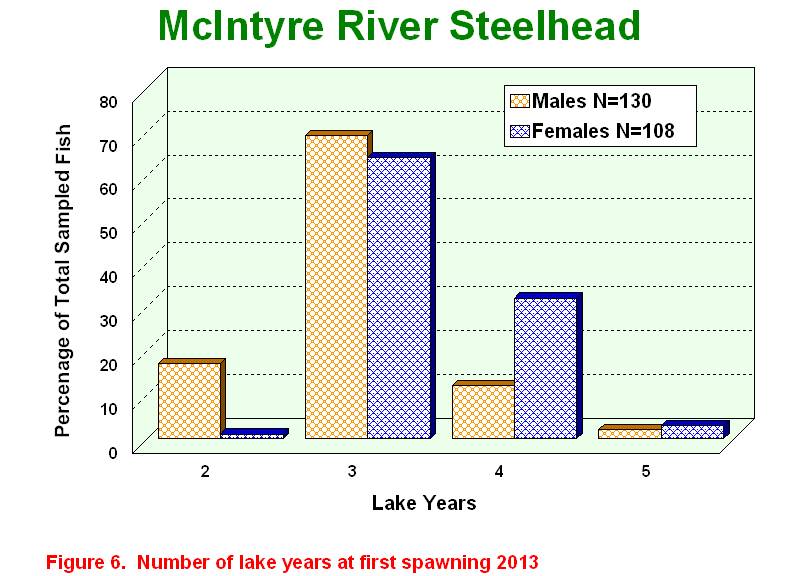Spawning
The spawning migration in the McIntyre River usually begins in late March to mid-April and extends into the first week of June, with the bulk of fish entering from mid-April to May. A smaller portion of the migration occurs in the fall – from September to November. Redd ( gravel nest) construction occurs from April to June. Fall migrating fish overwinter in suitable habitat (usually in the upper river) and are generally the first to spawn in the spring. Fall fish are often considered important to successful spawning in headwater locations. Males first spawn from age two to age five, or one to four lake years. Females begin maturing at age three, with age four being dominant, and they generally require at least two years in Lake Superior before reaching full maturity. Some females delay maturity to age five or six, after three or four lake years (Figure 5, Figure 6).
Repeat spawners can be six to nine years of age and from 60 to 75 cm in fork length, and are probably the most valuable adults in the steelhead spawning population. They produce more and larger eggs, and spawn in the best stream locations (Seamons and Quin 2010, Moore 2013). Repeat spawners contribute to the spawning population for several seasons. Seamons and Quin (2010) found that these steelhead produced the majority of offspring.
In both Portage Creek and the McIntyre River, recruitment dramatically increased when their adult populations shifted toward larger spawning numbers of older, repeat spawners.
Stray Rate and Movement Patterns
Based on twenty years of adult tagging in Portage Creek, wild steelhead utilize much of Lake Superior for feeding, but most return to their native tributary to spawn. The 2012 and 2013 adult steelhead tagging in the McIntyre River indicated that movement patterns in Lake Superior were similar to that of Portage Creek steelhead. Portage Creek tagged steelhead have been recovered in foreign rivers throughout the Lake Superior watershed. When the tagged fish were released, many returned to Portage Creek to spawn, indicating they were just visiting these rivers, not on a spawning run.
The stray rate of wild Portage Creek steelhead was estimated to be approximately two percent, allowing unique life history traits to be maintained. A total of 366 adult steelhead were tagged in the McIntyre River during the 2011, 2012 and 2013 spawning migrations. Only one tag return came from a foreign river, and that was the Neebing River. It shares the same river mouth with the McIntyre. A low stray rate to foreign rivers allows localized adaptations (life history characteristics and migration patterns) to be developed and maintained. In 1994, adults from the McIntyre River were tagged and transferred to Ferguson Creek, a tributary of the Current River, Thunder Bay area. In subsequent years, tagged fish from this transfer were recaptured back in the McIntyre River.


